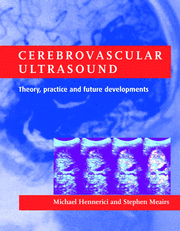Book contents
- Frontmatter
- Dedication
- Contents
- List of contributors
- Preface
- PART I ULTRASOUND PHYSICS, TECHNOLOGY AND HEMODYNAMICS
- PART II CLINICAL CEREBROVASCULAR ULTRASOUND
- PART III NEW AND FUTURE DEVELOPMENTS
- 25 Functional Doppler testing
- 26 Multigate emboli detection
- 27 Three- and four-dimensional cerebrovascular ultrasonography
- 28 Ultrasound contrast imaging
- 29 Ultrasonic thrombolysis
- Index
27 - Three- and four-dimensional cerebrovascular ultrasonography
from PART III - NEW AND FUTURE DEVELOPMENTS
Published online by Cambridge University Press: 05 July 2014
- Frontmatter
- Dedication
- Contents
- List of contributors
- Preface
- PART I ULTRASOUND PHYSICS, TECHNOLOGY AND HEMODYNAMICS
- PART II CLINICAL CEREBROVASCULAR ULTRASOUND
- PART III NEW AND FUTURE DEVELOPMENTS
- 25 Functional Doppler testing
- 26 Multigate emboli detection
- 27 Three- and four-dimensional cerebrovascular ultrasonography
- 28 Ultrasound contrast imaging
- 29 Ultrasonic thrombolysis
- Index
Summary
Introduction
Although three-dimensional ultrasound has only recently been applied for investigation of cerebrovascular disease, conceptual and technical developments of a multidimensional approach to ultrasonographic visualization and volumetry have occurred over more than two decades. The earliest report of three-dimensional imaging with ultra sound appeared in 1956 and described a technique for stereoscopic observation of body structures (Howry et al., 1956). Several years later a 3D ultrasonographic system for display of the human orbit was reported (Baum & Greenwood, 1961). This technique obtained serial parallel ultrasound images and then created a three-dimensional display by stacking sequential photographic plates of the images. Later, Dekker and coworkers described 3D ultrasound imaging of the heart with a mechanical tracking device to register images for volume reconstruction (Dekker et al., 1974). Although rapid developments in ultrasound scanning equipment, computer hardware and software have occurred since then, the basic requirements for producing three-dimensional ultrasonographic reconstructions have not changed; adequate two-dimensional images, known spatial relationship and orientation of each 2D image to a common external reference point, and techniques for volume reconstruction and visualization. This chapter will review the various approaches to meeting these requirements for three-dimensional ultrasound and then discuss current and emerging cerebrovascular applications of this technology.
Ultrasound data acquisition
A key determinant in the quality of any three-dimensional ultrasound application is the ultrasound equipment delivering the images. During the last decade we have witnessed signficant improvement in ultrasonographic image quality, due to new advances in transducer design and to rapid developments in computer hardware allowing realtime implementation of complex pre- and postprocessing algorithms.
- Type
- Chapter
- Information
- Cerebrovascular UltrasoundTheory, Practice and Future Developments, pp. 374 - 385Publisher: Cambridge University PressPrint publication year: 2001



